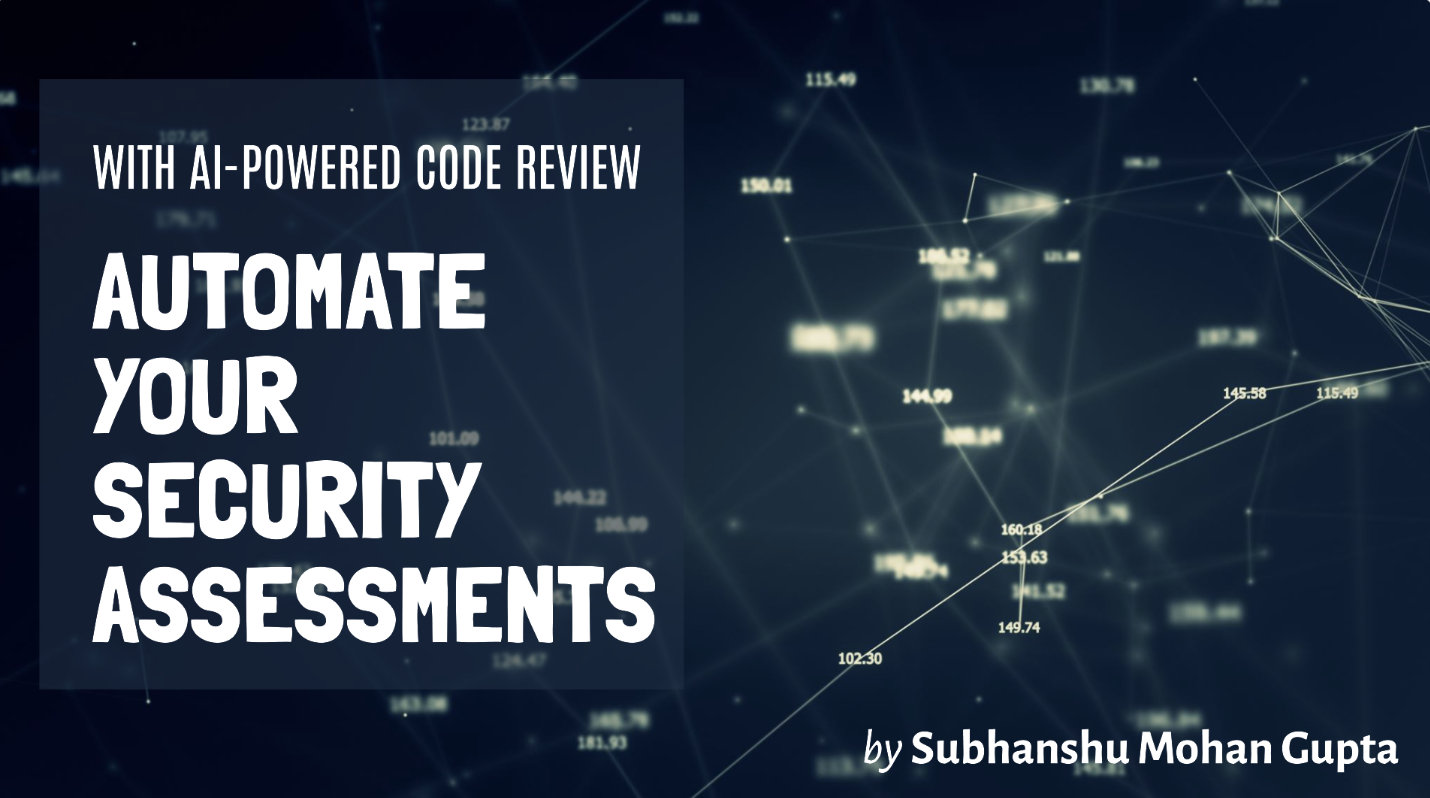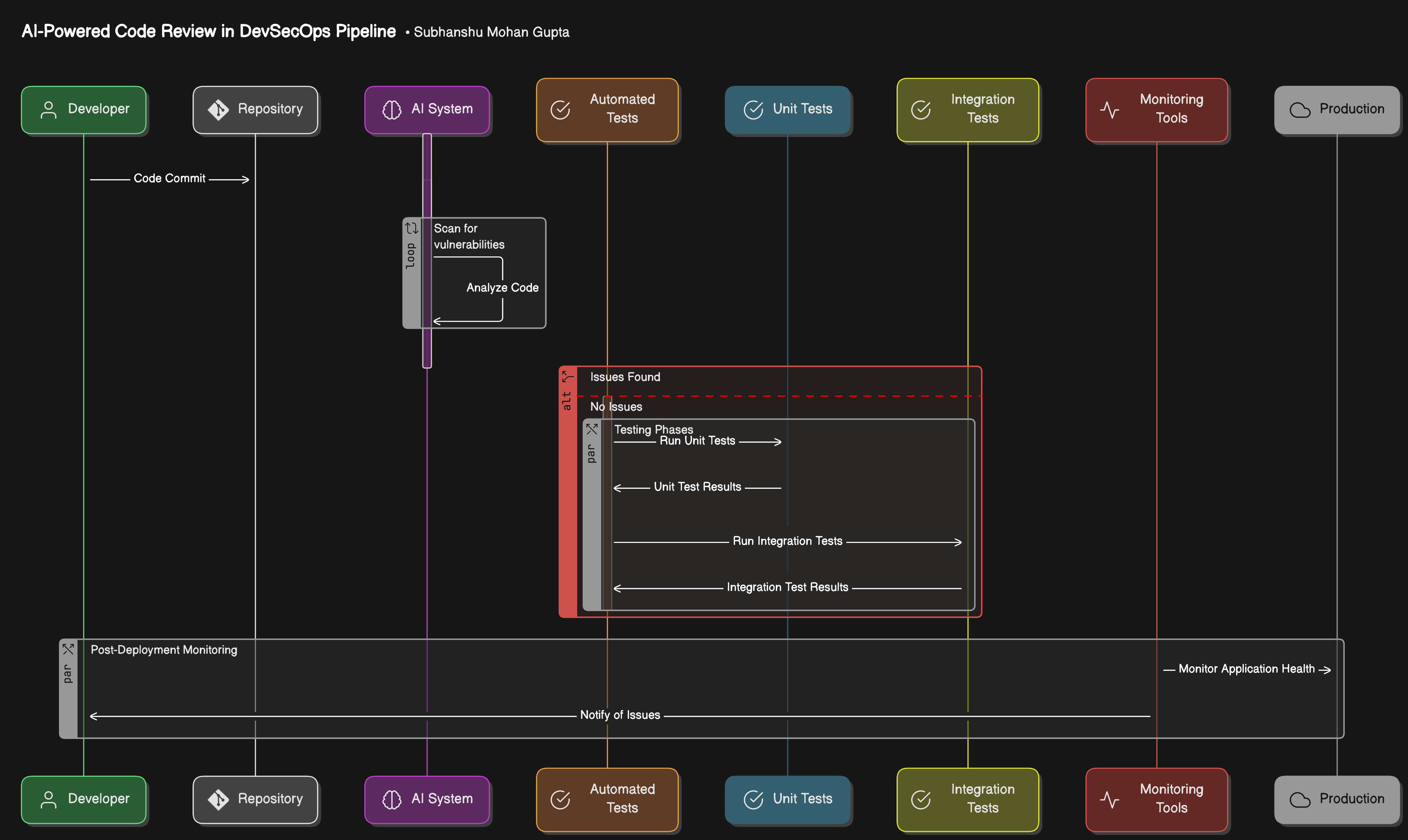Automating Security Assessments in the DevSecOps Pipeline: AI-Powered Code Reviews
 Subhanshu Mohan Gupta
Subhanshu Mohan Gupta
In the evolving landscape of software development, integrating security within the DevOps pipeline commonly referred to as DevSecOps has become a pivotal practice. Traditional code reviews, while effective, can slow down development and are prone to human error. Enter AI-powered tools: a game-changing innovation that automatically assesses code for vulnerabilities, code smells, and potential security flaws. In this article, we will explore the future of AI-driven code reviews, their impact on reducing human error, speeding up development cycles, and enhancing overall security posture.
The Future of Code Review: AI Takes the Helm
Conventional code review processes are labor-intensive and susceptible to oversight. With AI in the mix, these challenges are mitigated with precision and speed. AI-powered tools leverage machine learning algorithms and extensive datasets to automatically scan codebases, flagging issues that might escape human reviewers. This not only accelerates the development process but also ensures consistent and thorough security assessments, significantly reducing the risk of breaches.
Key Benefits of AI-Driven Code Reviews
1. Reduction of Human Error: AI identifies vulnerabilities and code smells that may be missed by human reviewers, ensuring a more comprehensive review process.
2. Faster Development Cycles: By automating the review process, developers receive instant feedback, allowing for quicker iterations and reducing manual review time.
3. Enhanced Security Posture: Continuous AI-driven assessments help maintain a strong security posture by consistently identifying and addressing potential flaws.
Real-World Example: AI in Action
Imagine a large e-commerce platform that deploys code updates multiple times daily. The manual code review process, although effective in spotting major issues, often misses subtle security flaws that could be exploited. Integrating an AI-powered code review tool into their DevSecOps pipeline changed the game.
Scenario: A developer pushes a new feature update involving complex logic for user authentication. While the update passes the initial manual review, the AI-driven tool flags a subtle session-handling vulnerability that could lead to session hijacking. The tool not only identifies the flaw but also suggests a fix, which the developer implements immediately. This early detection averts a potentially devastating security breach.
Implementing AI-Powered Code Review: A Creative Blueprint
1. Choose Your AI Tool Wisely:
- SonarQube, Snyk, or Codacy: Pick a tool that aligns with your project needs. These tools specialize in detecting vulnerabilities, code smells, and open-source dependency risks.
2. Seamlessly Integrate into Your CI/CD Pipeline:
- Modify Your CI/CD Pipeline: Add a stage for the AI-powered tool to scan code during the build process. For instance, in GitLab CI/CD, you might add:
code_review:
stage: code_review
script:
- sonar-scanner
allow_failure: false
3. Automate Feedback and Learning:
- Instant Feedback: Configure your tool to provide immediate feedback post-commit, and set up notifications to alert developers.
- Continuous Improvement: Ensure your tool learns from past code patterns, continuously improving its effectiveness.
4. Combine AI Insights with Human Oversight:
- Human Review: Despite AI's capabilities, final human review is crucial to ensure suggestions align with project standards.
5. End-to-End Testing Before Deployment:
- Automated Testing: Run comprehensive tests (e.g., using Selenium, JUnit) to validate AI-driven changes before merging code.
- Deploy with Confidence: Once validated, deploy the code through your CI/CD pipeline, ensuring a secure release.
Architecture Diagram

Explanation:
1. Code Commit: Developer commits code to the repository.
2. CI/CD Pipeline Trigger: Pipeline triggers, starting the build process.
3. AI-Powered Code Review: AI scans code for vulnerabilities, code smells, and security flaws.
4. Automated Feedback Loop: AI provides feedback, and developers are notified of issues.
5. Human Review: Developers review AI feedback and adjust accordingly.
6. End-to-End Testing: Automated tests validate changes.
7. Approval and Merge: Once validated, the code is approved and merged.
8. Automated Deployment: Code is deployed to production.
9. Continuous Monitoring: Monitoring tools ensure the application’s health post-deployment.
Conclusion
AI-powered code reviews are transforming the DevSecOps landscape by combining automation with advanced security assessments. This not only enhances code quality but also accelerates development cycles and fortifies security. By following this blueprint, organizations can seamlessly integrate AI-driven code reviews into their pipelines, ensuring a secure and efficient development process from start to finish. The future of code review is here, and it’s smarter, faster, and more secure than ever.
Subscribe to my newsletter
Read articles from Subhanshu Mohan Gupta directly inside your inbox. Subscribe to the newsletter, and don't miss out.
Written by

Subhanshu Mohan Gupta
Subhanshu Mohan Gupta
A passionate AI DevOps Engineer specialized in creating secure, scalable, and efficient systems that bridge development and operations. My expertise lies in automating complex processes, integrating AI-driven solutions, and ensuring seamless, secure delivery pipelines. With a deep understanding of cloud infrastructure, CI/CD, and cybersecurity, I thrive on solving challenges at the intersection of innovation and security, driving continuous improvement in both technology and team dynamics.